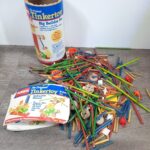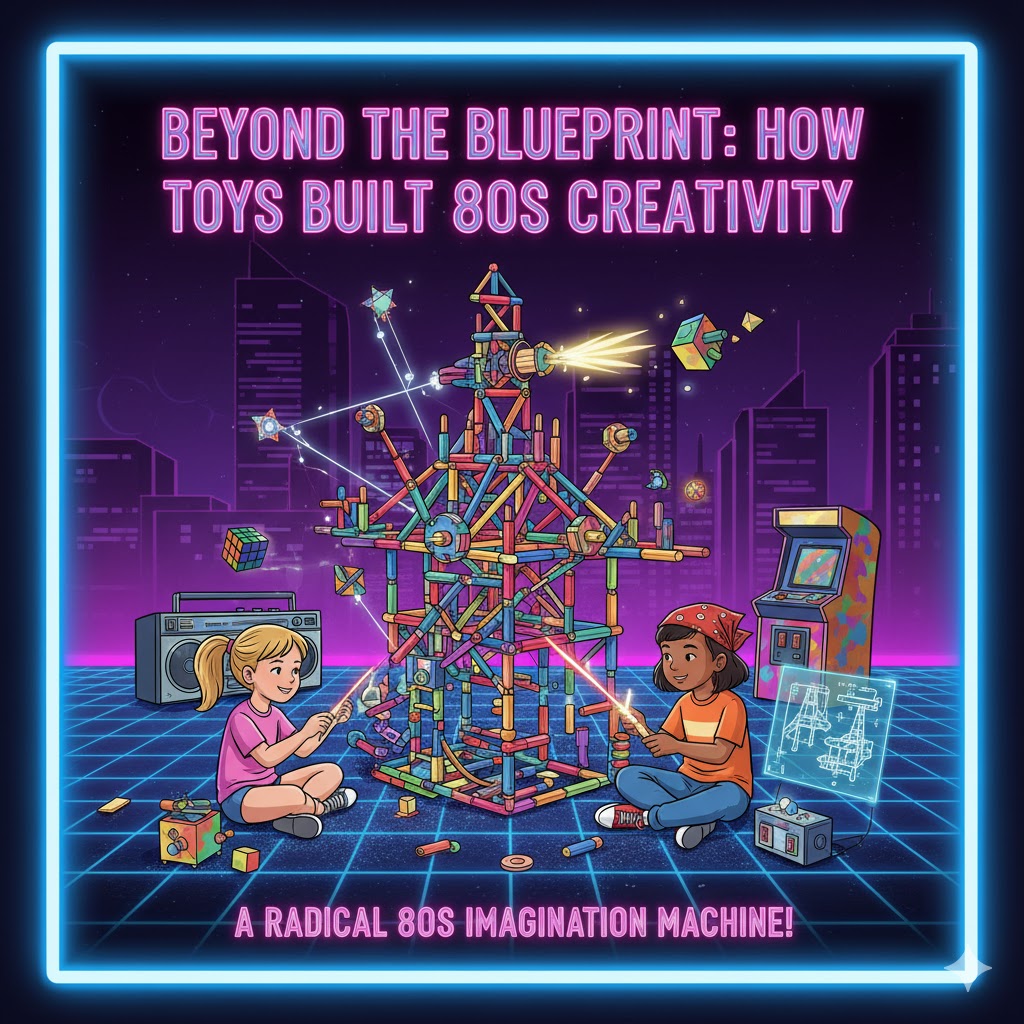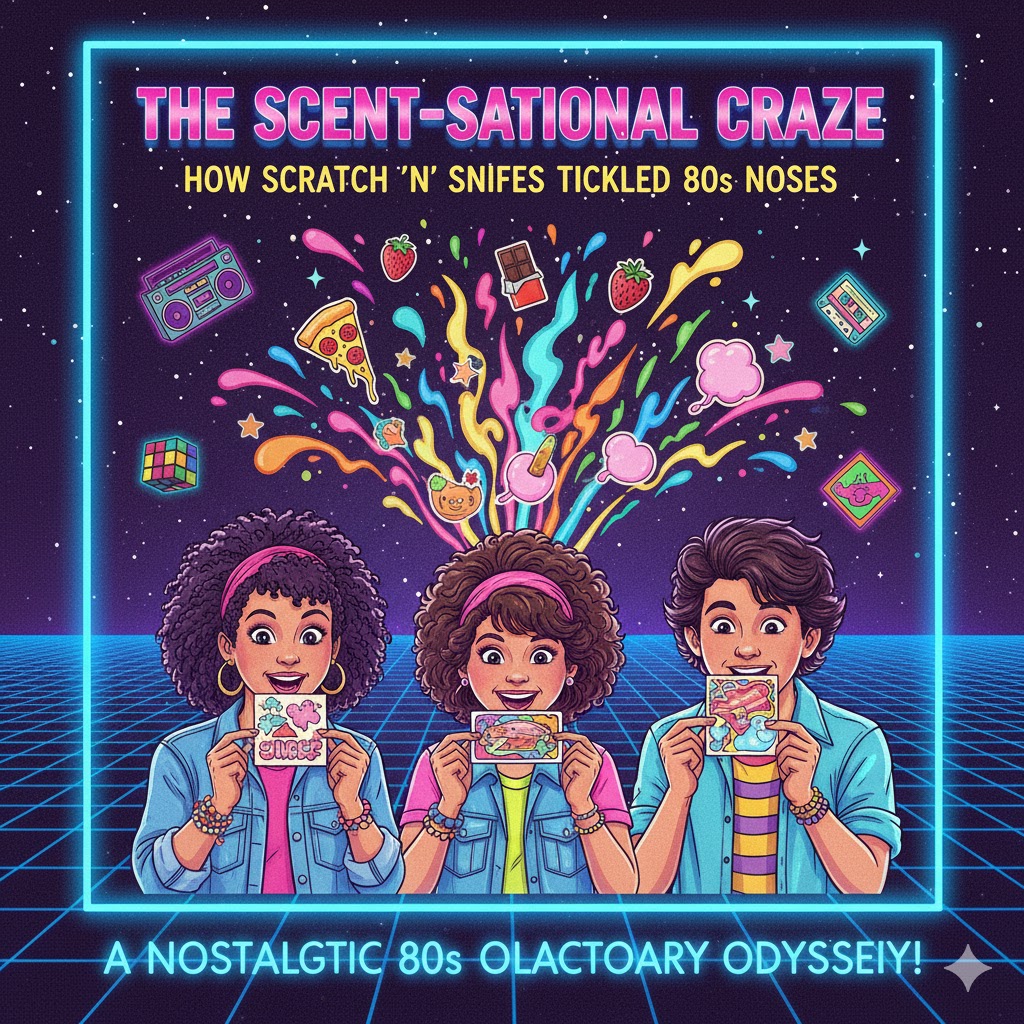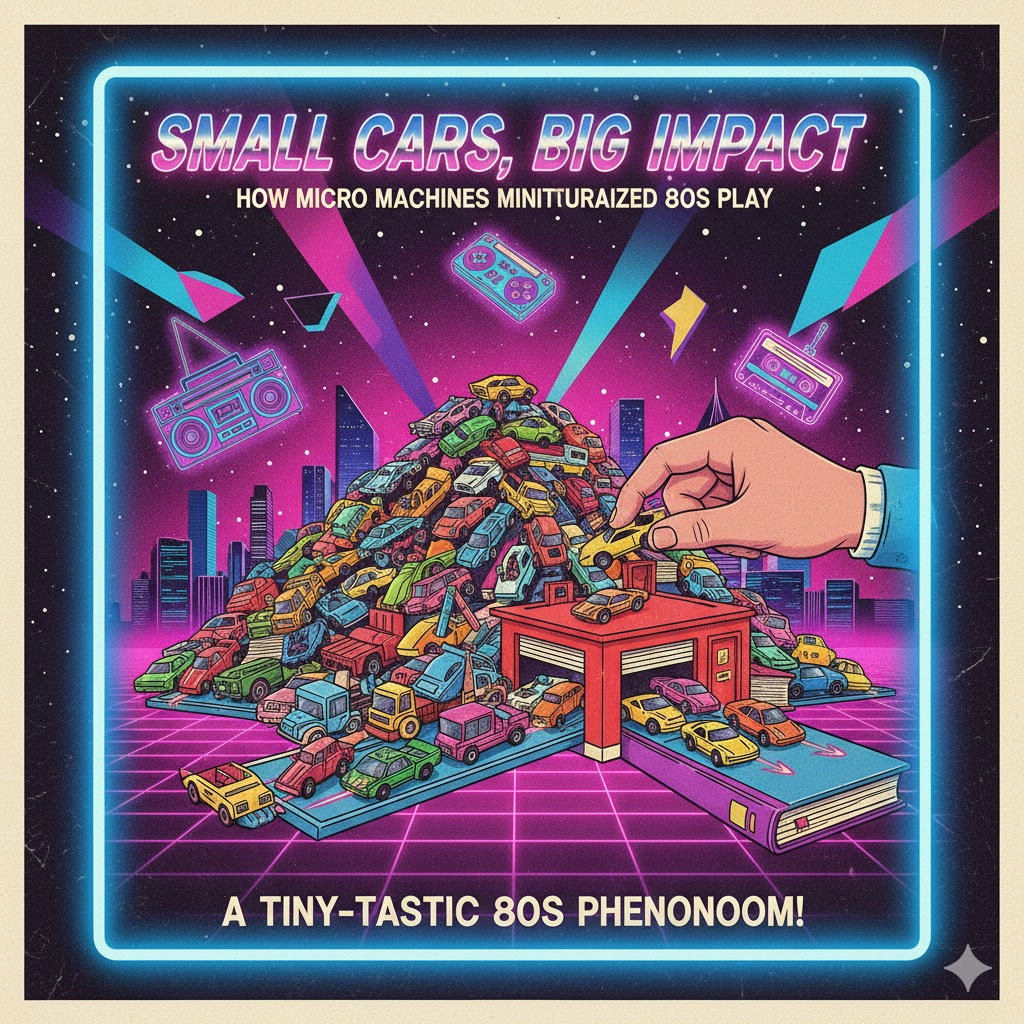 Tinker Toys were one of those rare toys that seamlessly bridged the gap between creative play and educational value, earning them a permanent place in the childhood memories of countless 1980s kids. Unlike action figures, dolls, or electronic games, Tinker Toys offered an open-ended building experience that allowed children to literally construct their imaginations, piece by piece. The iconic wooden sticks and spools, with their bright primary colors and interlocking design, weren’t just tools for play—they were instruments for exploration, problem-solving, and self-expression. Tinker Toys may seem simple by today’s standards, but in the 1980s, they represented a unique cultural phenomenon that influenced the way children thought, played, and connected with both their toys and each other.
Tinker Toys were one of those rare toys that seamlessly bridged the gap between creative play and educational value, earning them a permanent place in the childhood memories of countless 1980s kids. Unlike action figures, dolls, or electronic games, Tinker Toys offered an open-ended building experience that allowed children to literally construct their imaginations, piece by piece. The iconic wooden sticks and spools, with their bright primary colors and interlocking design, weren’t just tools for play—they were instruments for exploration, problem-solving, and self-expression. Tinker Toys may seem simple by today’s standards, but in the 1980s, they represented a unique cultural phenomenon that influenced the way children thought, played, and connected with both their toys and each other.
During the 1980s, Tinker Toys enjoyed a resurgence in popularity, despite having been introduced decades earlier in 1914 by Charles Pajeau and Robert Pettit. Their enduring appeal rested on their ability to grow with the child. For younger kids, the toys offered immediate visual satisfaction: bright colors, geometric forms, and simple assemblies provided fun and creative distraction. For older children, Tinker Toys challenged spatial reasoning, engineering skills, and creativity. With a relatively small collection of sticks, spools, wheels, and connectors, kids could construct towers, bridges, vehicles, or even abstract sculptures. The modular design encouraged experimentation and problem-solving, and the limitations of the pieces often sparked inventive solutions, fostering resilience and ingenuity.
Tinker Toys’ impact on 1980s pop culture was amplified by their integration into media and merchandising. The era’s emphasis on cross-platform branding meant that popular toys were often linked with cartoons, magazines, and competitions. Tinker Toys, though a more traditional toy, benefited from this cultural moment through creative advertising that highlighted both fun and education. Television commercials depicted children constructing imaginative creations, often paired with catchy jingles or narrations emphasizing creativity and problem-solving. These advertisements not only captured the attention of kids but also reassured parents that Tinker Toys were a beneficial and wholesome choice, combining entertainment with developmental value.
One of the most significant contributions of Tinker Toys to 1980s childhood was their role in fostering STEM skills before the concept was widely discussed. While the term “STEM” (Science, Technology, Engineering, Mathematics) wasn’t yet popularized, the toys provided a foundational experience in engineering and design principles. Children learned about balance, structural integrity, symmetry, and mechanical function, often without realizing they were engaging in educational play. Towers and bridges required careful planning; moving vehicles involved understanding axles and wheels; abstract creations encouraged exploration of shapes and geometry. Tinker Toys made these concepts accessible, fun, and engaging, giving children a hands-on experience with spatial reasoning and mechanical thinking.
The social aspect of Tinker Toys also contributed to their cultural significance. Children often collaborated on building projects, sharing ideas, and combining their pieces to create elaborate constructions. This cooperative play encouraged teamwork, communication, and problem-solving, reflecting broader cultural values of collaboration and creativity. Competitive building games, where children would challenge each other to create taller towers or more complex machines, added an element of excitement and skill mastery. Tinker Toys became a social medium, enabling peer interaction, friendship, and creative collaboration, all within the playful context of imaginative construction.
The aesthetic of Tinker Toys resonated with 1980s design sensibilities, particularly the decade’s fascination with bright colors, geometric patterns, and bold, playful forms. The red, yellow, and blue sticks and natural wood spools fit perfectly within the visual culture of the time, complementing other toys, art supplies, and media aesthetics. The simplicity and vibrancy of the pieces made them visually appealing and easy to incorporate into creative projects. This design versatility ensured that Tinker Toys could be appreciated both for their functional play value and for their visual appeal, contributing to their popularity as a toy line that was both educational and artistically engaging.
Tinker Toys also represented a counterbalance to the surge of electronic and action-oriented toys that dominated the 1980s market. Video games, battery-operated vehicles, and high-tech gadgets were capturing the imaginations of many children, yet Tinker Toys offered a low-tech, hands-on alternative that emphasized human creativity over digital engagement. The tactile experience of fitting sticks into spools, balancing structures, and experimenting with mechanical principles provided a satisfying contrast to screen-based entertainment. This analog, constructive play appealed to both children and parents who valued imaginative, hands-on experiences that could be shared and revisited indefinitely.
Merchandising and brand expansion further reinforced Tinker Toys’ cultural footprint. Beyond the basic building sets, specialized kits offered themed projects, such as vehicles, buildings, and machines, enabling children to explore different forms of construction and mechanics. These kits provided inspiration while maintaining the open-ended nature of play, allowing kids to either replicate instructions or create entirely original designs. The availability of expansion packs encouraged ongoing engagement, turning a modest initial investment into a growing toolkit of creative possibilities. This modular approach mirrored broader trends in 1980s toy culture, emphasizing both collectibility and extended play value.
Tinker Toys’ popularity was also reflected in school and educational settings. Teachers and educational programs often incorporated the toys into lessons on geometry, physics, and problem-solving. Their simplicity and versatility made them ideal for demonstrating mechanical principles, spatial reasoning, and collaborative learning exercises. The educational applications of Tinker Toys complemented their entertainment value, reinforcing the idea that play and learning could coexist harmoniously. This dual appeal enhanced their cultural significance, positioning Tinker Toys as a meaningful tool for both personal creativity and structured learning.
The nostalgic value of Tinker Toys cannot be overstated. For many adults who grew up in the 1980s, the sight of the colorful sticks and spools evokes memories of afternoons spent building towers, bridges, and vehicles with friends or siblings. The tactile satisfaction of fitting pieces together, the sense of accomplishment in completing a structure, and the imaginative narratives that accompanied each creation left a lasting imprint. These memories underscore the cultural resonance of Tinker Toys, demonstrating how a simple, hands-on toy could create enduring experiences that shaped a generation’s perception of creativity, play, and problem-solving.
The marketing of Tinker Toys in the 1980s highlighted the toys’ dual appeal: fun and education. Advertisements emphasized the limitless possibilities for construction, inviting children to imagine anything from futuristic vehicles to sprawling skyscrapers. Commercials often showcased children actively engaged, collaborating, and celebrating their completed projects, reinforcing the social and imaginative dimensions of the toy. By positioning Tinker Toys as both entertaining and developmental, the brand appealed to a wide audience, bridging the desires of children for imaginative play and the expectations of parents for meaningful, skill-building activities.
Tinker Toys also influenced contemporary design thinking and toy innovation. Their modularity, versatility, and open-ended play model inspired subsequent generations of building toys and construction sets. Many 1980s children who grew up with Tinker Toys would later gravitate toward more complex construction sets, robotics kits, and engineering-focused toys, demonstrating the long-term influence of these simple sticks and spools. Tinker Toys provided foundational experiences in creativity, mechanical reasoning, and spatial awareness, planting the seeds for future engagement with STEM-oriented activities.
The tactile, hands-on nature of Tinker Toys contributed to their role in promoting fine motor skills and dexterity. Manipulating small pieces, connecting sticks to spools, and balancing structures required precision and patience. These motor skills, while often taken for granted, played an important role in child development, reinforcing hand-eye coordination and spatial reasoning. Tinker Toys demonstrated that toys could simultaneously entertain and support developmental growth, embodying the dual-purpose philosophy that defined many of the most beloved toys of the 1980s.
Tinker Toys’ appeal also lay in their simplicity and timelessness. While trends in toys came and went, the fundamental concept of interlocking sticks and spools remained compelling across generations. Unlike toys tied to a particular media franchise or fad, Tinker Toys offered enduring value because the play possibilities were limited only by imagination. This open-endedness ensured that the toys remained relevant, adaptable, and engaging even amidst the flashy, high-tech, and media-driven toys of the 1980s.
Socially, Tinker Toys facilitated cooperative and competitive play. Children would often join forces to build larger projects than they could manage alone or compete to see who could construct the tallest tower or most intricate vehicle. These activities fostered problem-solving, negotiation, and collaboration, embedding social learning within play. The toys became tools not just for individual creativity but also for community-building, peer engagement, and imaginative teamwork, reflecting the broader cultural values of play and social development in the 1980s.
The cultural resonance of Tinker Toys extended into adult nostalgia and retro appreciation. Adults who grew up building with sticks and spools often recall the sense of accomplishment, creative freedom, and joy that came with constructing elaborate projects. The simplicity, versatility, and imaginative potential of Tinker Toys allowed them to transcend generational boundaries, inspiring retro toy revivals and continued appreciation in the decades that followed. Their enduring legacy demonstrates that a well-designed, hands-on toy can achieve both cultural significance and timeless appeal.
Ultimately, the significance of Tinker Toys in 1980s pop culture lies in their combination of simplicity, creativity, and developmental value. They offered children an unparalleled opportunity to explore, experiment, and express themselves through building and construction. The toys promoted spatial reasoning, problem-solving, social interaction, and imaginative storytelling, all while maintaining the joy and excitement of play. Tinker Toys were more than sticks and spools—they were catalysts for creativity, innovation, and cultural engagement.
For children growing up in the 1980s, Tinker Toys provided endless hours of entertainment, learning, and imaginative adventure. They represented a rare intersection of fun, education, and social interaction, allowing kids to create, collaborate, and explore in ways that transcended the toy itself. The cultural footprint of Tinker Toys is evident in their enduring recognition, nostalgic appeal, and influence on subsequent toy designs. They remain a testament to the power of open-ended, hands-on play in shaping childhood experiences and fostering lifelong creativity.
Tinker Toys were a defining element of 1980s play culture because they exemplified the era’s values of imagination, experimentation, and engagement. They encouraged children to think creatively, collaborate with peers, and solve problems, all within the joyful context of play. By combining accessibility, versatility, and educational potential, Tinker Toys left a lasting mark on both the toy industry and the cultural memory of a generation.
Even decades later, the legacy of Tinker Toys endures. Adults who remember building with sticks and spools often carry forward the lessons of creativity, patience, and problem-solving that these toys fostered. Tinker Toys remind us that play is not merely a pastime—it is a vehicle for learning, connection, and imagination. They proved that simple, thoughtfully designed toys could achieve cultural significance, shaping the childhoods of millions and leaving an indelible imprint on the pop culture of the 1980s.
Tinker Toys were more than just wooden sticks and spools—they were tools for creativity, social interaction, and intellectual exploration. They offered children a universe of possibility within a compact, accessible format, embodying the spirit of 1980s play culture. By encouraging imaginative construction, problem-solving, and collaborative engagement, Tinker Toys cemented their place as one of the most beloved and culturally influential toys of the decade. Their enduring legacy is a testament to the power of open-ended play and the timeless appeal of a toy that challenges the mind as much as it delights the imagination.



